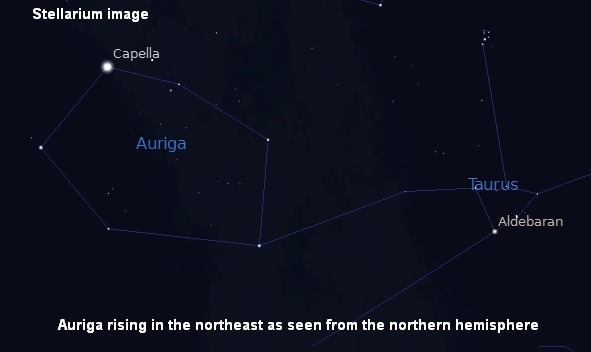¡SkyCaramba! Weekly astronomy blog for the week ending November 29, 2014
 One of the oldest constellations represents something that itself represents life in ancient times. Auriga is a charioteer. The stars form the shape of a charioteer’s helmet, but in constellation art it is often drawn to be the chariot.
One of the oldest constellations represents something that itself represents life in ancient times. Auriga is a charioteer. The stars form the shape of a charioteer’s helmet, but in constellation art it is often drawn to be the chariot.
In many old Greek stories, this constellation represents Hephaestus, the god of blacksmiths and craftsmen. Some of the most important work such people did 25 centuries ago may have been building chariots for kings and warriors.
Hephaestus, however, didn’t like war. Despite being a god, something happened to him that made him unable to walk. One story says his mother, the goddess Hera, thought him too ugly a child to keep. So she threw him off Mount Olympus. Upon splashing into the sea, he suffered broken legs. Another story says Zeus threw him into the sea during an argument with Hera and Hephaestus. In either version of events, Hephaestus survived and built an early version of the wheelchair.
In a complicated love story involving this constellation, King Oenomaus of Pisa would race in this chariot against any man who asked to marry his daughter. If the would-be groom lost, King Oenomaus would kill him. The king won many races. But one day, his daughter Hippodamia made a bargain with Myrtilus the chariot  driver to wreck the chariot. Pelops, who had come to marry Hippodamia, would win. However, Myrtilus believed Hippodamia would marry him instead. When Pelops won, he threw Myrtilus into the sea.
driver to wreck the chariot. Pelops, who had come to marry Hippodamia, would win. However, Myrtilus believed Hippodamia would marry him instead. When Pelops won, he threw Myrtilus into the sea.
Later legends associate the chariot with a herdsman transporting goats. Thus, the constellation’s brightest star has a name that suggests something to do with goats. Capella is actually two stars about 42 light years from us. They are both yellow, like our sun. Capella is sometimes called the goat star. A nearby triangle of stars is then called the kids.
One of those later legends says Zeus nursed from a goat where Capella is. Zeus broke off one of the goat’s horns. But he gave it the ability to pour forth great amounts of food and drink. The word cornucopia comes from this story.
When you are looking at Auriga, you are looking most opposite from the center of the Milky Way Galaxy. Scorpio is toward the center. For an observer in the northern hemisphere, Scorpio has just set in the southwest as Auriga rises in the northeast.
¡SkyCaramba!
http://stardate.org/nightsky/constellations/auriga
http://www.constellation-guide.com/constellation-list/auriga-constellation/
http://earthsky.org/constellations/closeup-on-auriga
http://www.topastronomer.com/StarCharts/Constellations/Auriga.php
